

www.farmboyzimsflightsims.com
FBZFS
Click On Any Picture For A Larger View
Thanks For The Visit !
Be careful flying this little rocket with wings! You just may leave your stomach behind! Commercial Level Simulations (CLS), along with Just Flight bring you an aircraft model that is a rather new concept in both real world and the Flight Simulation world as well, the VLJ Business Jet. VLJ stands for Very Light Jet, and is a concept of aircraft design that incorporates small size, speed, and comfort for those that have the bucks to spend on a ride like this! The aircraft resembles the Eclipse 500 which is a real world aircraft, but for reasons that are probably legal, CLS just went with the name VLJ Business Jet. If you want to own the actual aircraft, it will only run you about 1.5 million USD or so…pocket change!
CLS is a development company that most of you should be familiar with, as they have provided us simmers with some very entertaining products in the past. This product is offered in conjunction with Just Flight as part of their "F-Lite" series of aircraft. F-Lite models do not use complicated avionics, such as a Flight Mission Computers (FMC) and other advanced systems that you would find up front. This does not detract from the fun of flying these models. What they offer is a chance for the new simmer to have a go at handling aircraft other than the default models, without learning the pilot’s manual from cover to cover, and still have a challenging and fun model to fly.
CLS is a development company that most of you should be familiar with, as they have provided us simmers with some very entertaining products in the past. This product is offered in conjunction with Just Flight as part of their "F-Lite" series of aircraft. F-Lite models do not use complicated avionics, such as a Flight Mission Computers (FMC) and other advanced systems that you would find up front. This does not detract from the fun of flying these models. What they offer is a chance for the new simmer to have a go at handling aircraft other than the default models, without learning the pilot’s manual from cover to cover, and still have a challenging and fun model to fly.
The cockpit of the VLJ Business Jet utilizes the new Glass Panel, featuring a wealth of information at your fingertips. These new panels may seem a little intimidating at first, but you figured out how to turn your computer on, so I'm confident that you'll be able to figure out these new widgets as well! Besides, there is a tutorial flight that covers the basic functions of the aircraft. Most of the panel instruments are usable, and there isn't an over abundance of "dummy" buttons, knobs, etc., just a few for cosmetic effect. I really like the looks of these new panels and the amount of information that is easily displayed for you in a well laid out manner. The panel is easy to read for the most part, some items just a bit small to read, but to get a larger, easier view of the Nav display, System display, and other sub panels, there is a simicon bar in the lower left of the panel that allows you to bring up these panels into a larger view. Here's a hint for those of you that fly in full screen mode, that’s without the blue menu bar across the top of the screen...go to view…window view, then bring up your sub panels that you wish to display (all or a few, depending on how your system handles it) and if you have a second monitor, undock the sub panel and slide it over to your second monitor. This way, all nav and aircraft information is easily viewed, all the time, and you still have an unobstructed view out the aircraft. If you do not have a second screen, you can still resize the sub panel to fit better on your screen. This is true for most model panels. The pop up sub panels all look great and are easy to read and really look quite realistic. Very nice job!
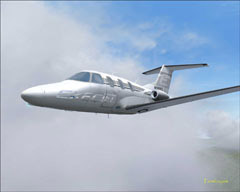
Models such as PMDG, Level-D, Captain Sim, etc, are a bit more advanced to operate, and usually have some extreme detail, inside and out, but nevertheless, CLS has done a fine job of balancing the cost of development to the cost of the product. These F-Lite models all are fairly priced so that many simmers across the board can afford them.
The product came to me on a disc, and the installation into both FS 2004 and FSX went so smooth that it is hardly worth a mention. These days, most product installations are pretty cut and dried, and do not take forever and a day to upload, although this always depends on the size of the product and your system. My rig put everything where it was supposed to go, with me nudging it onto the right path to FSX, since I have it on a separate hard drive. All in all, painless install.
From the nose to the tail, the aircraft is smoothly modeled, with just a few polygons here and there showing their unsmoothed faces, nothing too blatant though, you have to look real close. The textures, for both day and night look great. The control surfaces, landing gear, along with engine covers, wing-tip tanks, doors and stairs operate very smoothly. The extra animations are many, and also include a passenger with bags in hand, looking to me as if they're happy to be setting foot on solid ground again, a fuel truck that shows up with the wing fold command (you must assign a key or button command),
The product came to me on a disc, and the installation into both FS 2004 and FSX went so smooth that it is hardly worth a mention. These days, most product installations are pretty cut and dried, and do not take forever and a day to upload, although this always depends on the size of the product and your system. My rig put everything where it was supposed to go, with me nudging it onto the right path to FSX, since I have it on a separate hard drive. All in all, painless install.
From the nose to the tail, the aircraft is smoothly modeled, with just a few polygons here and there showing their unsmoothed faces, nothing too blatant though, you have to look real close. The textures, for both day and night look great. The control surfaces, landing gear, along with engine covers, wing-tip tanks, doors and stairs operate very smoothly. The extra animations are many, and also include a passenger with bags in hand, looking to me as if they're happy to be setting foot on solid ground again, a fuel truck that shows up with the wing fold command (you must assign a key or button command),
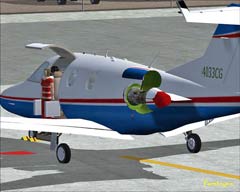
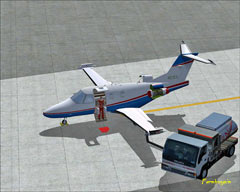
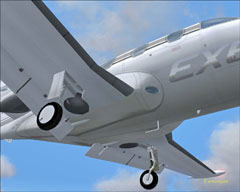
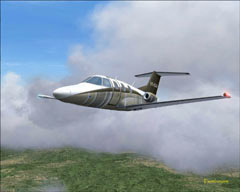
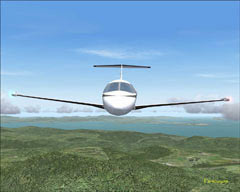
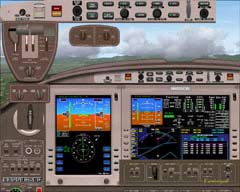
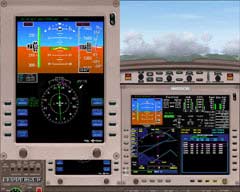
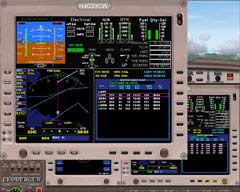

tire blocks, push back tractor, and last but not least, a square of red carpet to make the passengers feel extra special! The only thing that really stood out on the outside of the aircraft was the wingtip lights. They seemed to look like fuzzy balls of light, not quite connecting with the aircraft. A small matter, but hey, that's what I'm paying myself to notice! Remind me to ask me for a raise!
The aircraft comes in quite a few liveries; most are simple, clean and basic, while others are a bit on the "artistic" side. There were two or three that really caught my eye, but there are enough liveries to make anyone happy. All were nicely painted, and I’m sure you’ll see one that will catch your fancy as well.
The aircraft comes in quite a few liveries; most are simple, clean and basic, while others are a bit on the "artistic" side. There were two or three that really caught my eye, but there are enough liveries to make anyone happy. All were nicely painted, and I’m sure you’ll see one that will catch your fancy as well.

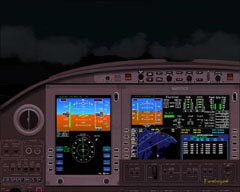
There were a few issues that I found while utilizing the avionics in this aircraft. The first being that when you enlarge one of the displays, and make any adjustments to the data on that enlarged display, it does not reflect those changes on the main panel view, although once the panel is out of view, the main panel does reflect the changes.
While using the Garmin G500 GPS, I found the only two ranges allowed were 20 miles and 50 miles. I wasn't really happy with this, as I sometimes like to get either a closer look or perhaps get my nose out there a hundred miles or so on the GPS range, just to get a better Situational Awareness (SA). I took a peek at the Avidyne Website, makers of the FlightMax EX5000, the MFD used in the VLJ model, and I was unable to find any information on the specifications regarding
While using the Garmin G500 GPS, I found the only two ranges allowed were 20 miles and 50 miles. I wasn't really happy with this, as I sometimes like to get either a closer look or perhaps get my nose out there a hundred miles or so on the GPS range, just to get a better Situational Awareness (SA). I took a peek at the Avidyne Website, makers of the FlightMax EX5000, the MFD used in the VLJ model, and I was unable to find any information on the specifications regarding
ranges. There were also some buttons that were labeled on the panel as doing one thing, but would perform a different task all together. An example of this is the range select button for the GPS on the MFD, which actually reads page down. Having your tool-tips turned on will help with these issues. I'm not exactly sure why this mislabeling of functions is there, perhaps to make it look authentic. I have posted a question about the range issue on the GPS in the Just Flight forums, and I am awaiting an answer on this. As of this writing, no reply. Other small panel issues include the absence of a clock, and a mach speed indicator.
Frame rates were a bit of a problem while in the VC mode, and this seems to be an issue across the board with others as well. I prefer the 2D cockpit anyway with this model. To improve frame rates while in the 2D mode, there are hidden click spots on the panel to hide various functions of the Primary Flight Display (PFD) and the Multi-function display (MFD). This makes quite a bit of difference with frame rates. It is a detailed panel, with loads going on, so I can see where it would drain the resources of slower computers.
I thought the night lighting in the aircraft, both up front and in the detailed cabin was really quite beautiful. Lights in the cabin and the cockpit can be dimmed from the panel.
I am pretty impressed with both the panel and interior that has been created for this model. You get a real sense of instrument flying using the glass cockpit. I am not sure if some of the issues that I mentioned above are fixable, but CLS is working on a patch for some known issues and will post it in the forum over at Just Flight when it is ready for download. Speaking of the forum, regarding the VLJ, there were not many posts regarding problems with the product, and it has been out for a while, so I think you can take this as a good sign!
Throughout the interior of the aircraft, you will find detailed extra’s scattered about. One that I was surprised to find was the ability to "slide" the pilot or copilot seats forward or backward, to allow for more room for your virtual legs. This is done with the mouse over the armrests of the seats. A neat little detail that did not have to be included, but was anyway for the realism effect. You have to admit that CLS does not skimp on the "extras" with some of their models! This one is loaded!
Frame rates were a bit of a problem while in the VC mode, and this seems to be an issue across the board with others as well. I prefer the 2D cockpit anyway with this model. To improve frame rates while in the 2D mode, there are hidden click spots on the panel to hide various functions of the Primary Flight Display (PFD) and the Multi-function display (MFD). This makes quite a bit of difference with frame rates. It is a detailed panel, with loads going on, so I can see where it would drain the resources of slower computers.
I thought the night lighting in the aircraft, both up front and in the detailed cabin was really quite beautiful. Lights in the cabin and the cockpit can be dimmed from the panel.
I am pretty impressed with both the panel and interior that has been created for this model. You get a real sense of instrument flying using the glass cockpit. I am not sure if some of the issues that I mentioned above are fixable, but CLS is working on a patch for some known issues and will post it in the forum over at Just Flight when it is ready for download. Speaking of the forum, regarding the VLJ, there were not many posts regarding problems with the product, and it has been out for a while, so I think you can take this as a good sign!
Throughout the interior of the aircraft, you will find detailed extra’s scattered about. One that I was surprised to find was the ability to "slide" the pilot or copilot seats forward or backward, to allow for more room for your virtual legs. This is done with the mouse over the armrests of the seats. A neat little detail that did not have to be included, but was anyway for the realism effect. You have to admit that CLS does not skimp on the "extras" with some of their models! This one is loaded!

This is an extremely fun aircraft to fly. The flight dynamics are almost like a jet fighter, but not quite. How's that for an expert, technical evaluation! Seriously though, she handles well, that is once you are used to this little job! You will want to pay attention to the tutorial in the manual, when it tells you to only apply about 75% N1 for takeoff. If you go full bore, you'll be imitating the Space Shuttle lifting off! There's a lot of power in those little engines back there, and they do a wonderful job of zipping you around the skies at a comfortable 275 knots or so. The over speed warning sounds off at about 290 knots. While we are talking about the speed of the aircraft, I want to mention that the auto-throttle at the higher speeds works, but actual indicated speed is off by a few knots from what is set on the auto pilot. Using manual throttle is a solution to this minor problem.
The auto pilot is very easy to use and understand. Most simmers should be able to figure it out with no problem, and new folks to the hobby will find that it’s a very user-friendly flight management system. Handling this aircraft manually is possible, as it is a small aircraft, but again, you have to get used to it if you are not accustomed to small, fast, jet aircraft. You have to think quicker to match the speed of your ride! If you have a few hours under your belt in small jet aircraft, you will probably feel right at home in the VLJ.
The auto pilot is very easy to use and understand. Most simmers should be able to figure it out with no problem, and new folks to the hobby will find that it’s a very user-friendly flight management system. Handling this aircraft manually is possible, as it is a small aircraft, but again, you have to get used to it if you are not accustomed to small, fast, jet aircraft. You have to think quicker to match the speed of your ride! If you have a few hours under your belt in small jet aircraft, you will probably feel right at home in the VLJ.
Here are the features of this model, as listed on the Just Flight webpage...
·Elevators and ailerons droop when Hydraulics are off
·Opening passenger door
·Opening engines (maintenance mode)
·Opening wingtips (maintenance mode)
·Engine covers for when engines are off
·Animated wheels
·Animated Gear
·Flaps
·Elevators
·Ailerons
·Rudder
·Nose wheel steering
·Rotating engine fans
·Wheels show compression on the ground
·Pilot heads turn when the aircraft banks
·Windscreen rain wipers
·Pilot seats adjust to allow pilot seat position (VC only).
The product comes in both the CD version as well as a downloadable version, both priced the same at £16.99 / €24.95 / $29.99. A fair price for what is offered in this package. This is a great aircraft for all simmers, experienced and new alike. It has a little bit of everything for all, ease of operation with just a bit of technical challenge thrown in involving the glass cockpit. I think you will enjoy this product. For repainters out there, a paint kit is included to make your own liveries for the VLJ.
System Requirements...
Flight Simulator FSX or 2004 Pentium IV 1.7 GHz PC (2.5GHz for FSX) 512Mb RAM (1GHz for FSX) 64Mb 3D graphics card (128Mb for FSX) Windows Vista/XP 210Mb hard drive space DVD-ROM drive. (FBZ Note...The call for a minimum of a 64Mb 3D graphics card (128Mb for FSX) is really shooting low I think. I can't see how anyone can enjoy these models with anything less than a 128 Mb graphics card, but that's just my opinion.)
Here's some screenshots of this fine model in action! Pay close attention to all the "eye candy" features for the external views of the aircraft as well as inside...
·Elevators and ailerons droop when Hydraulics are off
·Opening passenger door
·Opening engines (maintenance mode)
·Opening wingtips (maintenance mode)
·Engine covers for when engines are off
·Animated wheels
·Animated Gear
·Flaps
·Elevators
·Ailerons
·Rudder
·Nose wheel steering
·Rotating engine fans
·Wheels show compression on the ground
·Pilot heads turn when the aircraft banks
·Windscreen rain wipers
·Pilot seats adjust to allow pilot seat position (VC only).
The product comes in both the CD version as well as a downloadable version, both priced the same at £16.99 / €24.95 / $29.99. A fair price for what is offered in this package. This is a great aircraft for all simmers, experienced and new alike. It has a little bit of everything for all, ease of operation with just a bit of technical challenge thrown in involving the glass cockpit. I think you will enjoy this product. For repainters out there, a paint kit is included to make your own liveries for the VLJ.
System Requirements...
Flight Simulator FSX or 2004 Pentium IV 1.7 GHz PC (2.5GHz for FSX) 512Mb RAM (1GHz for FSX) 64Mb 3D graphics card (128Mb for FSX) Windows Vista/XP 210Mb hard drive space DVD-ROM drive. (FBZ Note...The call for a minimum of a 64Mb 3D graphics card (128Mb for FSX) is really shooting low I think. I can't see how anyone can enjoy these models with anything less than a 128 Mb graphics card, but that's just my opinion.)
Here's some screenshots of this fine model in action! Pay close attention to all the "eye candy" features for the external views of the aircraft as well as inside...
The range of the aircraft is a bit over 1,000 miles with four occupants, so cross country trips are certainly in the aircrafts envelope. San Francisco to Los Angeles is about a 1 hour trip, in two hours, you can be down into Baja California and with a maximum IFR range, you can almost make it to Puerto Vallarta, Mexico. You better stop and juice up first if you want to enjoy your vacation on the beaches there! Going north out of KSFO with MAX IFR ranges will put you well up into Canada. So you can see that the “cruisability factor” (highly technical term) of this aircraft is quite far reaching for an aircraft of this size.
I enjoyed flying this model more in FS 2004 than I did in FSX, although in FSX the performance of the aircraft was the same as in FS2004, but I had a bit more of a frame rate hit in FSX. Also, my "flying environment" is better looking, so far, in FS 2004, so that's where you will find me in the VLJ! Other's have had the same issues, but I believe this is something that will heal with time (and probably some upgrades to the system). I am glad that developers are making the effort to make these models available to users of both sim versions.
As far as sounds go, the engine sound files were made based on what the developers thought they may sound like. Not a lot of examples out there to record I suppose. They do sound mighty powerful for itty-bitty engines though! I think it would make an impression flying overhead! Other ambient sounds are there as well, flaps operating, doors, etc. No call outs are included in this product.
I enjoyed flying this model more in FS 2004 than I did in FSX, although in FSX the performance of the aircraft was the same as in FS2004, but I had a bit more of a frame rate hit in FSX. Also, my "flying environment" is better looking, so far, in FS 2004, so that's where you will find me in the VLJ! Other's have had the same issues, but I believe this is something that will heal with time (and probably some upgrades to the system). I am glad that developers are making the effort to make these models available to users of both sim versions.
As far as sounds go, the engine sound files were made based on what the developers thought they may sound like. Not a lot of examples out there to record I suppose. They do sound mighty powerful for itty-bitty engines though! I think it would make an impression flying overhead! Other ambient sounds are there as well, flaps operating, doors, etc. No call outs are included in this product.








The size of this aircraft is quite small, which is why it is able to get into and out of small airstrips. These shots give you an idea of the size compared to other aircraft...
The Manual that comes with the product is in a printed booklet form (BIG THANK YOU!), and is in English, French, and German. It is 26 pages long and contains brief explanations of most of the functions of the aircraft. The most important part of the manual is the tutorial from San Francisco International (KSFO) to a small coastal strip about 170 miles north of San Francisco, Shelter Cove. The tutorial is intended to familiarize you with the operations of the VLJ, and even if you have experience in the glass cockpit, it would not hurt for you to take the tutorial anyway, just to get an idea of where everything is located and how the FlightMax avionics suite works.
It does a good job of getting you up in the air in no time, but it does have a few errors in it. I think a bit more time needs to be spent on proof reading before publishing, just to make sure the information is correct (i.e., The VLJ is NOT an Airbus and as such, has no "Airbus knobs" to turn as stated in the FAQ's in the manual). It won't take much longer to make the manual look as professional as the product is. Nobody is perfect, and I am a living example of this! Overall though, a good, concise manual!
It does a good job of getting you up in the air in no time, but it does have a few errors in it. I think a bit more time needs to be spent on proof reading before publishing, just to make sure the information is correct (i.e., The VLJ is NOT an Airbus and as such, has no "Airbus knobs" to turn as stated in the FAQ's in the manual). It won't take much longer to make the manual look as professional as the product is. Nobody is perfect, and I am a living example of this! Overall though, a good, concise manual!
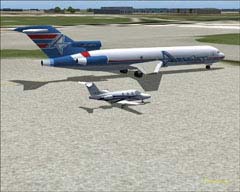
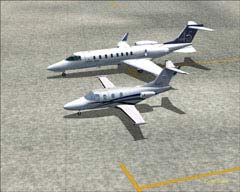
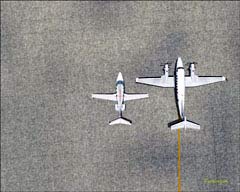
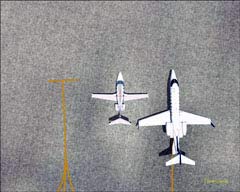






For more information on this and other great products, visit www.justflight.com
VLJ Business Jet
Just Flight and CLS
By Farmboyzim
Just Flight and CLS
By Farmboyzim
